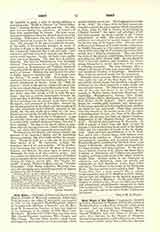

Grey Nuns of the Cross, a community founded in 1745 at Montreal by Madame d’Youville, known as the Grey Sisters, or Grey Nuns, from the color of the costume. Just one century later, February, 1845, at the request of Bishop Phelan, Kingston, Mother General McMullin sent four sisters to Ottawa, Ontario, then Bytown, in the Diocese of Kingston. Schools being the greatest need at Bytown, two classes were opened without delay, Sisters Elizabeth Gruyere and Helen Howard being the first teachers. Over one hundred and fifty pupils attended. This was the beginning of the well-known Sacred Heart or Rideau Street Boarding School. At the same time, a sister in charge of the sick poor organized the laity into helping centers. Providentially a hospital was in working order when the ship-fever victims arrived from Ireland in the famine year of 1847. Teaching and the works of mercy are on a footing in this community. The Grey Nuns undertake any needed good work. Their novitiate receives choir nuns and lay sisters. The institute has so steadily increased that it has in Ottawa, in addition to Rideau Street convent, two high schools and sixteen parochial schools. The teachers hold summer schools, attend the normal summer school and qualify for the highest diplomas.
Attached to the hospital is the first training-school for nurses formed in Canada. There are also five homes for children and the aged poor, supported by voluntary offerings and a government allowance. In Hull, opposite Ottawa, are large parish schools, academic and elementary. A Catholic normal school will be opened in September, 1909. At Hudson Bay is an Indian school for the Crees; along the Ottawa River from its upper waters are three boarding schools, ten parochial schools and five hospitals; at Lake St. Peter, in Quebec province, are two boarding schools and an Indian school for the Abnaki. In 1857 a school was opened in Holy Angels parish, Buffalo, N. Y. It is situated on Porter and Prospect Avenues and has had a very successful history.
In 1860 a boarding school and academy was founded at Plattsburg, N. Y. A parish school, governed by the public school principal and supported by the public school funds, existed until the “Garb-question” caused the sisters to withdraw. Plattsburg School Board sent protests in vain to Albany. There was but one answer: the exciting garb must be discarded. But the school still exists, supported by Catholics. In 1863 a school was opened at Ogdensburg, N. Y., in the old Ford mansion, on a beautiful site, facing the St. Lawrence. It is now a home for the homeless. St. Mary’s or the Cathedral school of Ogdensburg is second to none under the Regents. At the World’s Fair it was accorded a medal in the exhibit of the University of New York. The sisters have also two hospitals at Ogdensburg. Since 1881 Lowell and Haverhill, Mass., have had parochial schools. Leo XIII proclaimed Mother d’Youville venerable. Her canonization is being considered at Rome. As she, the first Grey Nun, chose the Cross as her emblem, and the object of her special devotion, Leo XIII named her faithful daughters “Grey Nuns of the Cross”, a title limited to the Ottawa foundation only, the headquarters of the houses mentioned above.
SISTER VERONICA O’LEARY

